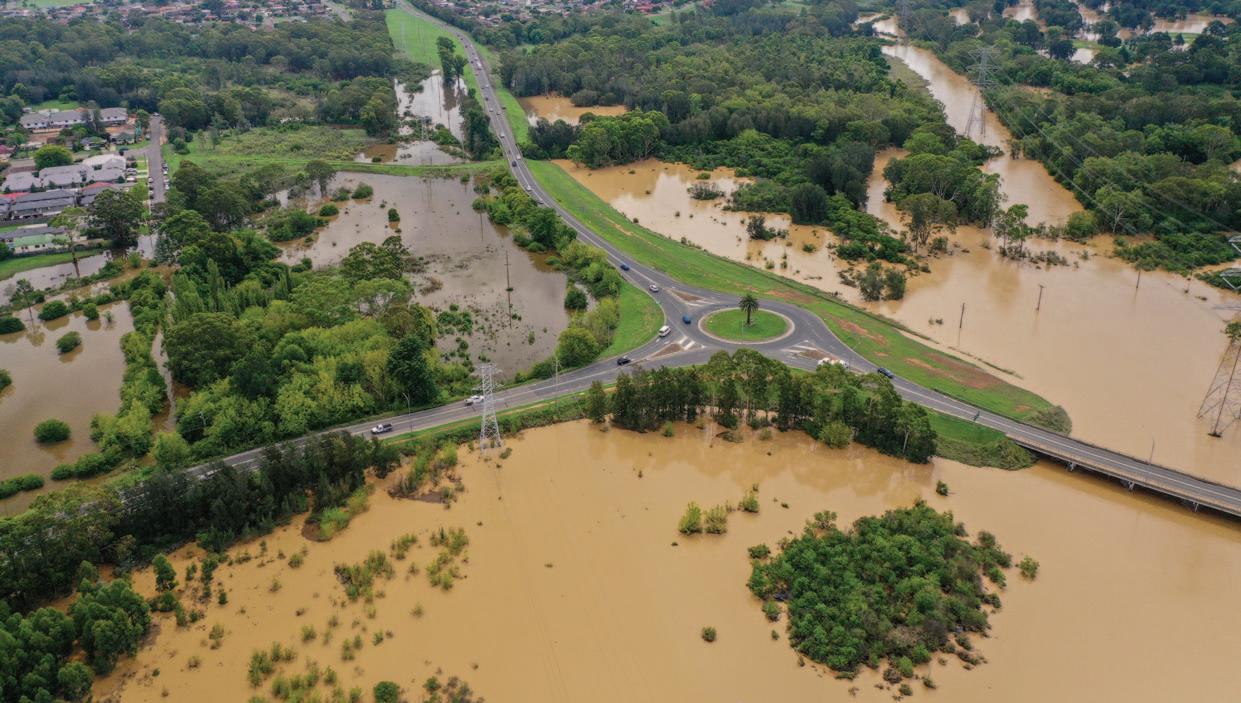
5 minute read
After the deluge
AFTER THE
DELUGE
Advertisement

David Pech documents the past, present and future of disasters in the Hawkesbury.
In February, the Intergovernmental Panel on Climate Change — the IPCC — released its Sixth Assessment Report on the scientific, technical and socio-economic effects of climate change.
The 3,765-page report emphasised the increasing future likelihood of “complex, compound and cascading risks”. This presents a grim prospect for the community of the Hawkesbury, who have endured five disasters in three years.
First, there was the devastating Black Summer fires. Then in 2020, flooding and the COVID pandemic. Then worse flooding in 2021. And early this year, flooding that even exceeded last year’s event.
PAST
Inner Sydney Voice has been working in community disaster preparedness since 2017, and in the Hawkesbury since 2019. ISV began its work in the preparedness space with the Get Ready for Flood project in mid-2019. Get Ready for Flood was a cooperative venture between ISV, Infrastructure NSW, social housing residents, community housing providers, and other key stakeholders.
Community surveys undertaken in 2018 revealed that there was a lack of awareness of flood risk and limited preparedness undertaken within social housing communities in the Hawkesbury.
The social housing sector was identified as a “community of concern” due to the high concentration of social and physical vulnerability. Around 3,300 social housing properties were deemed to be at risk — either directly by floodwater, or by having essential services cut off.
Through the Get Ready for Flood project, social housing residents strengthened their individual flood preparedness. ISV developed resources and training in collaboration with residents, providers and key stakeholders — such as emergency services.
ISV found that the most effective way to engage residents was through group training and discussions. Community-centred emergency planning followed — and it was a success. ISV developed a facilitator guide, which is now available as a tool for other communities to strengthen their disaster readiness.
At the end of 2019, the Hawkesbury was hit by the Gospers Mountain megafire. It was the largest bushfire from a single ignition point in Australia’s history. The fire directly impacted the outer communities of the Hawkesbury — burning up to Wiseman’s Ferry in the north and Bilpin in the west.
The Gospers Mountain fire joined with five other blazes and ultimately destroyed 90 homes and burnt more than a million hectares. The fire was contained and then finally extinguished in February 2020 by rain. However, the rain brought another disaster to the Hawkesbury — flood.
Using the Bureau of Meteorology metric, the 2020 flood was rated moderate. But many people in the Hawkesbury community had not lived through similar flooding before and so, for them, the flood, while deemed moderate, was a major event. Sixty-five properties were directly impacted and 200 residents were evacuated.
In a report to a state government select committee, Infrastructure NSW concluded that had the upstream Warragamba Dam been full, these impacts would have been tenfold. As it turned out, these impacts would eventuate — the moderate flood of 2020 presaged greater flooding in 2021, and again in 2022.
By the bureau’s metric, the March 2021 flood proved to be a major event. The water level at Windsor peaked three metres higher than the 2020 flood, impacting more than 400 dwellings in the Hawkesbury, as well as more than 1,400 “manufactured homes” in caravan parks.
Yet again, the Hawkesbury community was impacted by a new disaster while attempting to recover from preceding catastrophes. Recovery efforts were further hampered by the risks and restrictions of the ongoing COVID pandemic — which particularly impacted communities with limited or no internet access.
PRESENT
This year’s flood exceeded the 2021 event by more than a metre, with waters reaching 13.8 metres at Windsor. The breadth of impact of the latest flood remains to be seen. Assessment of the material damage is continuing. The Hawkesbury City Council estimates that more than 10 percent of roads have been seriously damaged, and that repairs will take more than a year.
The damage will hinder recovery and reconnection in communities that are already isolated from the metropolitan centres of the Hawkesbury. Many residents who were worst impacted by the floods are the community’s most vulnerable members — social housing residents, people with disability, older people, culturally and linguistically diverse people, and people without access to key resources like secure housing, personal transport and the internet.
The Hawkesbury community is facing the compounding impacts of multiple disasters. These impacts are complicated by the temporal nature of disaster recovery services — supports for the Black Summer fire have been winding down as supports for the 2021 flood wind up — and now a new set of response and recovery needs are pressing.
The mood amongst community organisations is an understandable mix of determination, fatigue and frustration. In the face of increasing climate disasters, we must contemplate the possibility that disaster response and recovery is now part of “business as usual” for the already stretched community sector.
FUTURE
The NSW government has announced an inquiry to examine the 2022 floods in Lismore and the HawkesburyNepean. The inquiry will investigate causes, preparation, response and recovery. It is already evident from disasters across the country — and around the world — that strengthening community and community organisations is crucial to disaster resilience, response and recovery.
Professor Amanda Howard and Associate Professor Margot Rawsthorne from the University of Sydney collaborated with ISV to develop recommendations from the Get Ready for Flood project.
They concluded that vulnerable members of the community and community organisations must have a voice in emergency planning. Government and emergency services must collaborate with — and support — community in the face of increasing frequency and severity of disasters. Strong, empowered, well-resourced partnerships from across the community are needed to meet the challenges of an ever-worsening climate crisis.
ISV has commenced a new project to strengthen community through disasters in the Hawkesbury. The project is funded through the Department of Regional NSW’s Bushfire Local Economic Recovery fund. Although this funding comes out of the Black Summer fires, the remit is broad: to develop connection and collaboration between community organisations in the Hawkesbury in the face of disasters of all kinds.
The need is clear: the IPCC projects climate change impacts — including floods and fires — will become “increasingly complex and more difficult to manage” going forward.
At the time of writing, the Bureau of Meteorology predicts another week of intense falls in the Hawkesbury with the risk of flash flooding. The complexity and difficulty projected by the IPCC is already evident and urgent in the Hawkesbury.
n If you would like to donate to support people affected by the 2022 flood, please visit givit. n To engage with ISV’s disaster resilience work, please contact resilience@innersydneyvoice.org.au n David Pech is the Community Resilience Project Officer at Inner Sydney Voice










